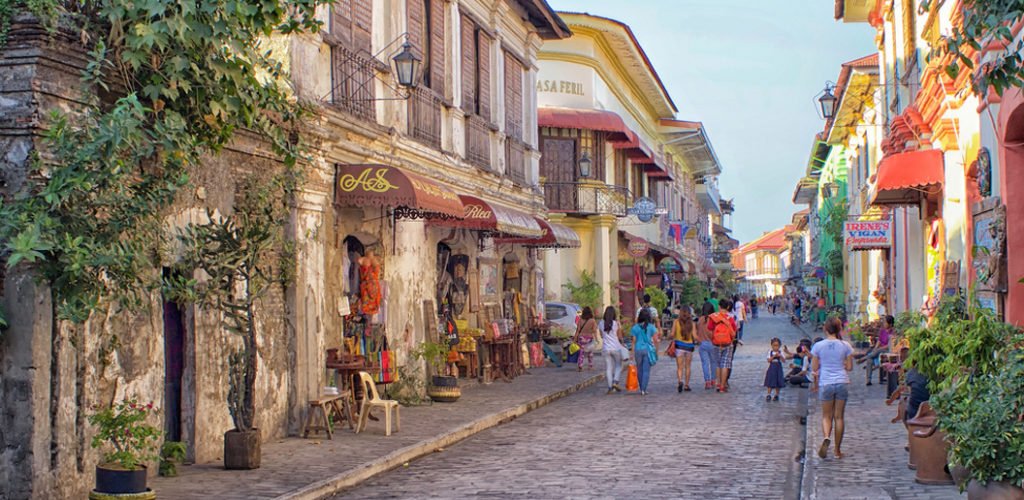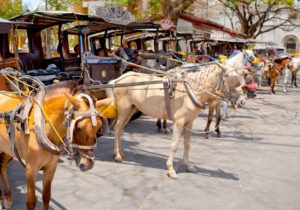 If you want to travel to the past in class, if you want to walk into a magical Spanish-Colonial domain, and experience a fascinating blast from an earlier point in time of wide endless stone paved streets without going all the way to Europe, the Historic City of Vigan in the Philippines is just the choice for you.
If you want to travel to the past in class, if you want to walk into a magical Spanish-Colonial domain, and experience a fascinating blast from an earlier point in time of wide endless stone paved streets without going all the way to Europe, the Historic City of Vigan in the Philippines is just the choice for you.
Vigan was established in the 16th century, making it one of the oldest towns in this historically packed country. From royalty to revolutionaries, lots of big names in the world of colonialism, politics and power have gone through this city. For instance, a fun fact of the City of Vigan is that it is the birthplace of the sixth president of the Philippines Mr. Elpidio Quirino.
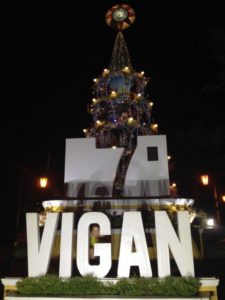 The City of Vigan is a Romeo and Juliette kind of fairy tale setting with row after row of colonial stone buildings which take you to the ancient streets of Malaga (Spain) without having to move from Asia. The gregarious town allows you to enjoy the tidbits of exquisiteness which modernity has stripped away from us; from long promenades in the pedestrian friendly environment from dawn to twilight, to short enjoyable carriage trips exploring hidden corners of the ancient town of Vigan as would have a duke or duchess of the time. This UNESCO World Heritage Site never seems to disappoint.
The City of Vigan is a Romeo and Juliette kind of fairy tale setting with row after row of colonial stone buildings which take you to the ancient streets of Malaga (Spain) without having to move from Asia. The gregarious town allows you to enjoy the tidbits of exquisiteness which modernity has stripped away from us; from long promenades in the pedestrian friendly environment from dawn to twilight, to short enjoyable carriage trips exploring hidden corners of the ancient town of Vigan as would have a duke or duchess of the time. This UNESCO World Heritage Site never seems to disappoint.
Vigan was declared as the most well preserved example of a Spanish colonial town in Asia by UNESCO in 1999. In 2015 Vigan city was recognized officially as one of the New 7 Wonders Cities alongside Doha, Durban, Beirut, Kuala Lumpur, La Paz and Havana, placing a second South East Asian city to the list with great pride.
 What is surprising, is that the magic is found within what some could call, ‘just another noisy Filipino town’. However, if you are of a sensitive nature you will be quick to appreciate Vigan’s exclusivity. The swift aroma of freshly baked traditional Spanish patties dangling in the air, and the unique antique and pottery shops which fill up the streets with the overflow of various items such as wooden trunks, unpaired chairs and vintage collector items that make it hard for one to enter the establishments selling them. The rawness of this city in every one of its cultural aspects; its buildings, the small businesses and the liveliness of the streets are some of the characteristics that make this old city unlike any other.
What is surprising, is that the magic is found within what some could call, ‘just another noisy Filipino town’. However, if you are of a sensitive nature you will be quick to appreciate Vigan’s exclusivity. The swift aroma of freshly baked traditional Spanish patties dangling in the air, and the unique antique and pottery shops which fill up the streets with the overflow of various items such as wooden trunks, unpaired chairs and vintage collector items that make it hard for one to enter the establishments selling them. The rawness of this city in every one of its cultural aspects; its buildings, the small businesses and the liveliness of the streets are some of the characteristics that make this old city unlike any other.
Vigan is known to be the most outstanding example of a planned Spanish Colonial town in Asia. Its architecture is a clear reflection of the fusion of Filipino, Chinese, European and Mexican elements which in turn create the idiosyncratic multi-cultural townscape that is Vigan. A city that is unlike any other found anywhere on the face of this planet. Its location, at the delta of Abra River alongside the coastline of the main island of Luzon, made it one of the important trading posts much before the colonial era. The flow of two additional rivers, the Mestizo River and the Govantes River made the city famous for being detached from the mainland by the three rivers flowing through and around it. However, after the silting of the Mestizo, Vigan is no longer separated from the mainland.
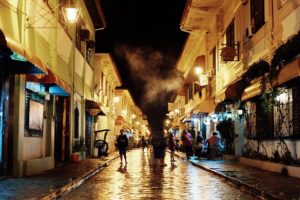
Its considerate urban plan conforms with the Renaissance grid plan used in all of the towns which used to form part of the Spanish Empire. This urban design made Vigan consist of two main plazas, Plaza Salcedo and Plaza Burgos, which are dominated by the St. Paul’s Cathedral, the Archbishop’s Palace, the City Hall and the Provincial Capitol Building. All which form part of the must-sees for any interested visitor.
The 233 string of historic buildings meticulously placed along a grid of 25 streets are mostly two storey buildings built purely with brick and wood with steep roofs which one could deduce are extracted from typical Chinese architecture. The exterior walls are covered by wooden window frames made of capiz shells which are specially designed to enable a refreshing ventilation to the insides of the buildings. In addition, the urban plan of the city has made Vigan City be subdivided into 39 beautiful barrios which is the Spanish word for neighbourhoods and which are also referred to as barangays by Filipinos.
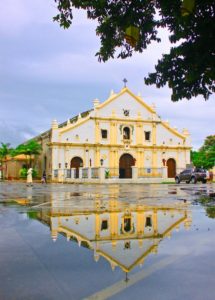 The traditional structures of the buildings have kept their authenticity not only with the maintenance of the grid urban plan and the use of open spaces such as the plazas but also with the usage of the buildings themselves. The traditional use of these buildings was for commerce on the ground floor and as a residence to owners on the higher floors; since colonial times the City of Vigan intends to keep it the same way.
The traditional structures of the buildings have kept their authenticity not only with the maintenance of the grid urban plan and the use of open spaces such as the plazas but also with the usage of the buildings themselves. The traditional use of these buildings was for commerce on the ground floor and as a residence to owners on the higher floors; since colonial times the City of Vigan intends to keep it the same way.
Not only is Vigan’s historical relevance the only attraction it boasts of, in addition it has plenty of things to do, especially plenty of things to see. In Vigan one can go skydiving, enjoy the nearby spas, go on beautiful boat tours around the coast of the city, and even take a dip at the nearby beaches. But one must also be an avid observer to truly enjoy Vigan. 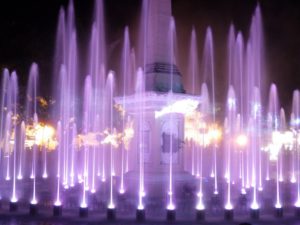 Some of the must-sees include various museums such as the National museum, the Padre Burgos House which enlightens visitors with Philippines’ history and culture, the Crisologo Museum and the Buridek Children’s Museum. Other sightseeing monuments are the many churches the Spaniards left behind with important historical backgrounds, these include; the famous Archbishops Palace an old Spanish Church which opens at the prior request of guests, the St Augustine Church, and the St. Paul Metropolitan Catheral. Other architectural landmarks include The Quirino Bridge also known as the St. Augustine Bridge; sunsets and sunrise become unforgettable here, the Banaoang Bridge, the Chapel by the Ruins, Plaza Burgos found at the Heart of Vigan, Plaza Salcedo famous for its dancing water fountains, and the Bantay Bell Tower, a scenic place where one can learn just a little more of Vigan’s history.
Some of the must-sees include various museums such as the National museum, the Padre Burgos House which enlightens visitors with Philippines’ history and culture, the Crisologo Museum and the Buridek Children’s Museum. Other sightseeing monuments are the many churches the Spaniards left behind with important historical backgrounds, these include; the famous Archbishops Palace an old Spanish Church which opens at the prior request of guests, the St Augustine Church, and the St. Paul Metropolitan Catheral. Other architectural landmarks include The Quirino Bridge also known as the St. Augustine Bridge; sunsets and sunrise become unforgettable here, the Banaoang Bridge, the Chapel by the Ruins, Plaza Burgos found at the Heart of Vigan, Plaza Salcedo famous for its dancing water fountains, and the Bantay Bell Tower, a scenic place where one can learn just a little more of Vigan’s history.
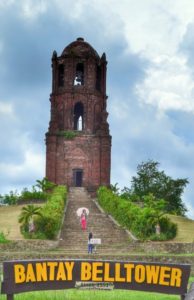 As in every recommended place, the places to visit are many, but the gastronomical culture must not lose its importance. Vigan has great eateries especially food that must be tried out in the greatness of the plazas of the city. The much-acclaimed empanada, longanisa and kankanen are most definitely a must-try, but there is a lot more than that to try in Vigan. The city’s culinary culture is mostly simple and seems to always try to enhance the natural flavour in each of its ingredients keeping its dishes fresh, straightforward and by doing so; very interesting.
As in every recommended place, the places to visit are many, but the gastronomical culture must not lose its importance. Vigan has great eateries especially food that must be tried out in the greatness of the plazas of the city. The much-acclaimed empanada, longanisa and kankanen are most definitely a must-try, but there is a lot more than that to try in Vigan. The city’s culinary culture is mostly simple and seems to always try to enhance the natural flavour in each of its ingredients keeping its dishes fresh, straightforward and by doing so; very interesting.
Pinakbet for instance is a mixture of eggplant, bitter melon, okra and squash cooked with fermented shimp or sun-dried pork belly, fried prior to mixing it with the vegetables to create a crunchy texture. Plaza Burgos is a great place to try out an order of arroz caldo or chicken porridge, pancit Vigan or soupy miki noodles and okoy or deep fried shrimps mixed with flour and eggs. Filipinos have these during regular meals or even as a snack at any random time of the day.
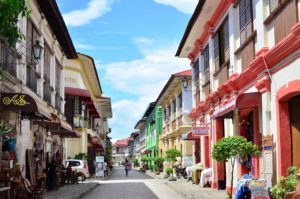 Another popular place to try out local food is the local Vigan Public Market. Here, one can try out lumo (a soup made with pork blood, pork tenderloin and green onions), pipian (cooked chicken with ground rice and other special local ingredients), poqui-poqui (mashed eggplant with egg), caldereta (a local beef stew), pinapaitan (a bitter meat dish, made with either beef or goat bile and innards) and sinanglao (a beef broth with beef innards) at its most authentic version in the local market.
Another popular place to try out local food is the local Vigan Public Market. Here, one can try out lumo (a soup made with pork blood, pork tenderloin and green onions), pipian (cooked chicken with ground rice and other special local ingredients), poqui-poqui (mashed eggplant with egg), caldereta (a local beef stew), pinapaitan (a bitter meat dish, made with either beef or goat bile and innards) and sinanglao (a beef broth with beef innards) at its most authentic version in the local market.
However, if these local gourmet spots do not please your aesthetic palette, Vigan food can also be tasted at more comfortable settings, for instance at the Vigan heritage Mansion where one can try the bagnet, dinengdeng, longanisa and pinakbet. Café Leona is also another favourite, offering International and Vigan fusion food to please the international palette.
Vigan City is located 408 Kilometres from Manila. Most people will take the bus, which is an eight to ten hour trip. The bus schedule includes a night bus so you can sleep during the drive and wake up in Vigan early in the morning. Alternatively, you can take a 45-minute flight from Manila to Laoag International Airport and from their it is a two hour drive to the city.
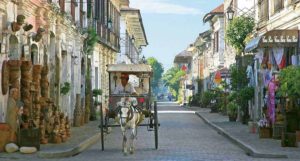 The City of Vigan is in conclusion, Philippines’ little gem. The combination of its multi-cultural historical value, adjacent to its defined architectural structures and its local culinary delicacies make it a city for the mind of a curious traveller. It is not with ease which one finds a city which is a melting pot of cultures in all the aspects Vigan happens to be. The best of Asia, Europe and parts of Latin America combined to form one only city must not be wasted while it is still alive, well and running.
The City of Vigan is in conclusion, Philippines’ little gem. The combination of its multi-cultural historical value, adjacent to its defined architectural structures and its local culinary delicacies make it a city for the mind of a curious traveller. It is not with ease which one finds a city which is a melting pot of cultures in all the aspects Vigan happens to be. The best of Asia, Europe and parts of Latin America combined to form one only city must not be wasted while it is still alive, well and running.


